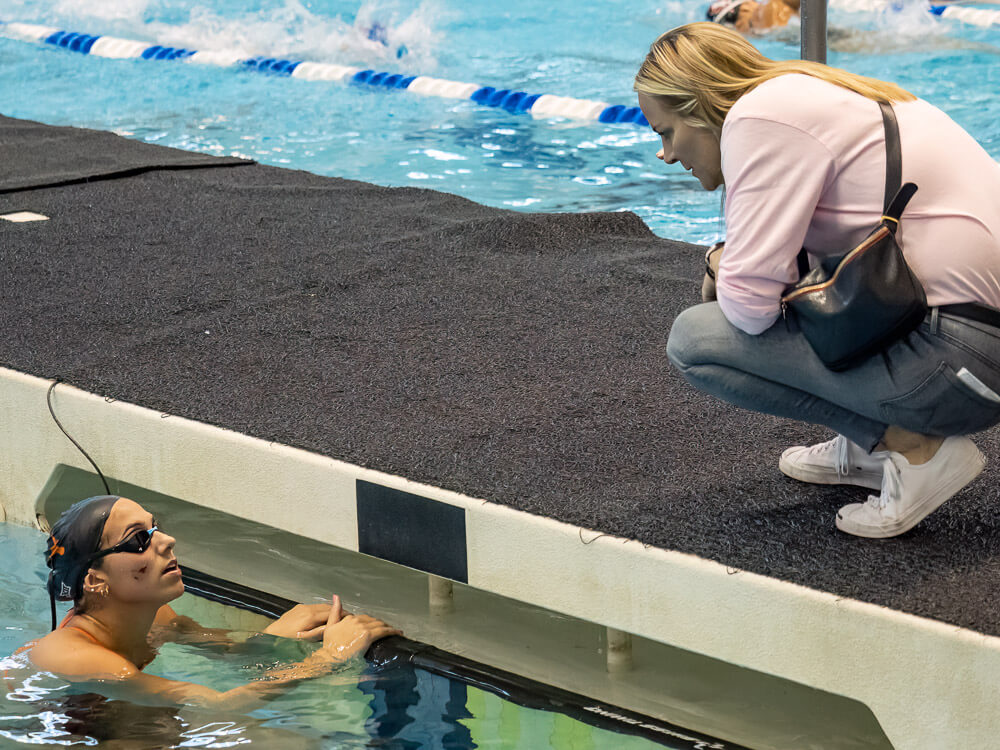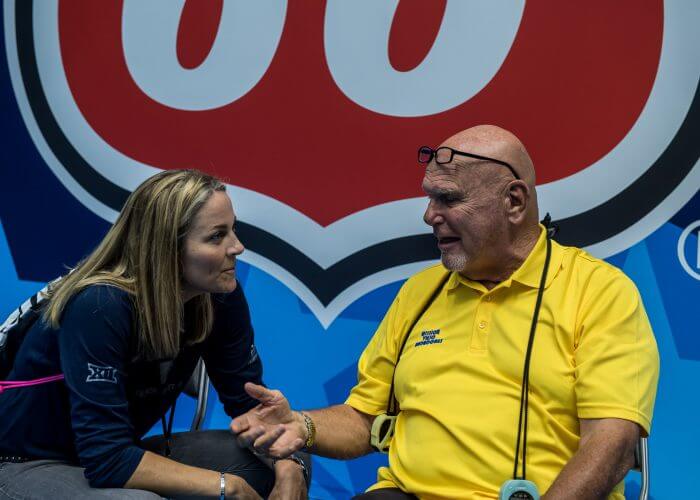Tough Talk: The Hard Conversations Between Coach and Athlete (Top Leaders Weigh In)

Tough Talk: The Hard Conversations Between Coach and Athlete
Seven coaches from around the country discuss the importance of a strong coach-athlete relationship. The common denominator is to show how much they care and to have their athlete’s best interests at heart when “having the hard conversations.”
************************
The cold truth can hurt. “To be a good leader, you have to have the hard conversations,” says Carol Capitani, head women’s coach of NCAA runner-up University of Texas. “Sometimes I have to really be careful and cautious about how I am coming across. I put a lot of thought into it so people can see that I am coming from a place of honesty and love—and that I respect them as an athlete and a person to even have a hard conversation with them. If I don’t care, I’m not going to dig in and have that discussion,” she says.
“The times I do my worst coaching is when I see and feel something, and I don’t address it. I don’t do my athlete or myself any favors by not addressing a situation just because it is difficult.
“Such decisions and conversations are the hardest part of the job. And just because I have them doesn’t mean it will go the way I want it. There is joint ownership in the process. But if I have the talk, then I have done all I can to get them going. If both of us do the right things all the way, hopefully we’ll get through the issues successfully. If we don’t, we won’t.
TOUGH LOVE
“Those conversations are harder today,” reiterates legendary former Florida coach Gregg Troy. “The key word in dealing with them is honesty. If you are honest with swimmers and they respect the honesty, then it becomes a starting point for improving whatever the problem might be and acceptance of constructive criticism that shows you have their best interests at heart.
“Any time that there is a confrontational situation with an athlete, it becomes especially important that you finish with an understanding that you have their best interests at heart. I always tried before the end of practice to explain what happened, why it happened and where we want to go with it. A majority of the time, those talks had a happy ending. So, it’s honesty, whether they believe you and what your relationship is with them. The better the relationship, the better they can handle honesty. There is a lot of give-and-take involved,” says Troy.

Photo Courtesy: Peter H. Bick
“I prided myself on being able to get things across to athletes on a one-on-one basis,” says Mission Viejo coach Bill Rose. “The secret is doing that on a daily basis and being listened to. I also let them know that I cared more than they did. Ultimately, I wanted the athletes to care as much as I did—and they had to work within themselves to do that.
“In practice, I could read what kind of effort they gave. If it was good, I let them know it; if it wasn’t, I voiced my displeasure. I wanted them to know that I wasn’t going to accept less effort. Bottom line: don’t be afraid to let go on your kids, but at the end of the day, make sure you finish with some kind of constructive counseling,” he says.
Chris Davis, founder/owner of SwimAtlanta, is in his sixth decade of coaching. He has counseled athletes through personal problems, practice effort and attendance travails—often creatively. One day he identified insufficient application from potential junior national scorers. “I made them sit in the bleachers and cheer for others in the practice. Later I explained that without better practice effort during finals at junior nationals, they’d be in the stands cheering for teammates.
“Another time I clocked swimmers walking around the pool. Then I timed them again, taking two steps forward, one step back. My point was that when you miss practice or don’t give good effort, improvement takes much longer. That exercise was much more effective than me just talking,” he says.
MOVING FORWARD
“What I try to do when there has been a disconnect between coach and athlete is to take swimmers back to the goals they set at the beginning of the year,” says Joel Shinofield, USA Swimming’s managing director of sport development. “I’d go through a checklist to see if they are actually moving toward their goals. I’d say this is what you told me you want to accomplish; this is what it takes. And you are not on track.
“In the past, some athletes have professed really high goals, and it became apparent early on those goals weren’t going to be met because of the work being done. At that point, I gave the athlete two choices: adjust the goal or adjust the pursuit of the goal. In all my years of club, college and high school coaching, there hasn’t been one year where I haven’t had that conversation. That’s coaching. It’s more than technique, more than training—it’s opening your athlete’s understanding of the sport.”
AN EPIPHANY – BACK TO RELATIONSHIPS
Shinofield shares the story, “My high school coach Neil Anderson understood what motivated me. He copied pages of splits from Ernie Maglischo’s Swimming Fast. ‘If you want to achieve this time, this is what you’ve got to go out in,’ he told me. Every day in practice, I knew my paces and what I had to hit. Neil knew I was analytical. Instead of saying I wasn’t fast enough, he gave me a tool to figure that out. From that moment on, my effort level changed. That taught me a lot as a coach, that I wasn’t going to respond to being yelled at. In connection with an athlete, trust matters.”

Photo Courtesy: Peter H. Bick
Someone admired for his connections with athletes is Jack Roach who, from 2008-13, was USA Swimming’s national junior team director. Roach has coached virtually every level of swimmer from age grouper to Olympian. “I think a really good coach asks more questions than gives answers,” he says. “Start by understanding your athlete; you’ll know their culture by the way they dress and the way they talk.”
Immediately after a race, “the first 30 seconds will make or break a relationship,” he says. “After a bad swim, I’ll ask, ‘Were you unable or unwilling?’ If unable, that’s a pretty easy conversation to have because it’s an adjustment in training. If unwilling, that’s a much deeper conversation. Fundamentally, it goes to how one is trying to set up their life. Are they trying to see what they can accomplish or trying not to fail? If the latter, they are going to worry about what might go wrong. Then, whether in practice or a meet setting, we are talking about mental toughness.
“It is a daunting task for coaches to teach mental toughness when someone is failing repeatedly. My definition of mental toughness is just this: When nothing is going well, look at the next most important thing. Teaching optimism and resilience are teachable skills. The reason the teaching is hard is because people have to be failing in order to be taught. And when they are failing, they don’t want to hear it. So it comes down to carving out a relationship where they know you really care. Great leadership is really that: How much are you willing to care? If they don’t trust you, there is nothing you can do. If they do, a lot can be accomplished,” Roach says. “So whatever you know or don’t know—just care!”
A MATRIX
“Coaches today need to be a Swiss Army knife,” says Frank Busch, six-time NCAA coach of the year and former U.S. national team director. “Today is just a different time. You must be very aware of what you say, how and where you say it, and in what context.” With his college teams, Busch always tried to educate team members and hold them accountable. “I wanted them to know that the actions they took affected the team, athletic department, university, not to mention their families. I told them they had to be aware of their choices and that I would hold them accountable.”
Ahh, accountability. “It appears this generation is not as open to hard conversations and self-accountability,” says Paris Jacobs, owner and CEO of multi-site Machine Aquatics (Vienna, Va.). “It’s a different environment. Hard conversations are just that—hard. They are much harder and different in today’s environment because of accountability. We see a lot from parents and athletes who want it to be 100% positive—that everything is going to be OK. They never want to hear anything negative. Sometimes you have to be aware of the negative—to work through things you can do better and bring out the best in ourselves.”
As a precaution against swimmer and parent blowback, Jacobs constantly counsels her staff on proper behavior and response. “When we are challenged, we ask, ‘How did we get here, what is our part, what is their part, what could we have done better, what do we need to learn from this?’
“I have spent a lot of time this year reminding people that membership is a privilege. Machine takes its responsibility to kids seriously and wants parents to respect that. We have a code of conduct. If our membership guidelines do not work for you, that’s fine…no hard feelings. As long as expectations and communication are out there, I am happy to have conversations about the rules.”
Occasionally such talks lead to asking someone to leave the program. “We work very hard to find a respectful resolution,” says Jacobs, “including, ‘We are not the program for you.’ We will help them find a better place, and a lot of parents are receptive to that,” she says. “My job is to protect the program culture and integrity beyond the now for future generations.”
* * *
In the here and now, much of swimming revolves around being in the present: “Living in the moment teaches lessons even if it is a failed experience,” says Roach. “It also gives a path and direction to go in—one guided by…caring.”
Michael J. Stott is an ASCA Level 5 coach, golf and swimming writer. His critically acclaimed coming-of-age golf novel, “Too Much Loft,” is in its third printing, and is available from store.Bookbaby.com, Amazon, B&N and book distributors worldwide.



